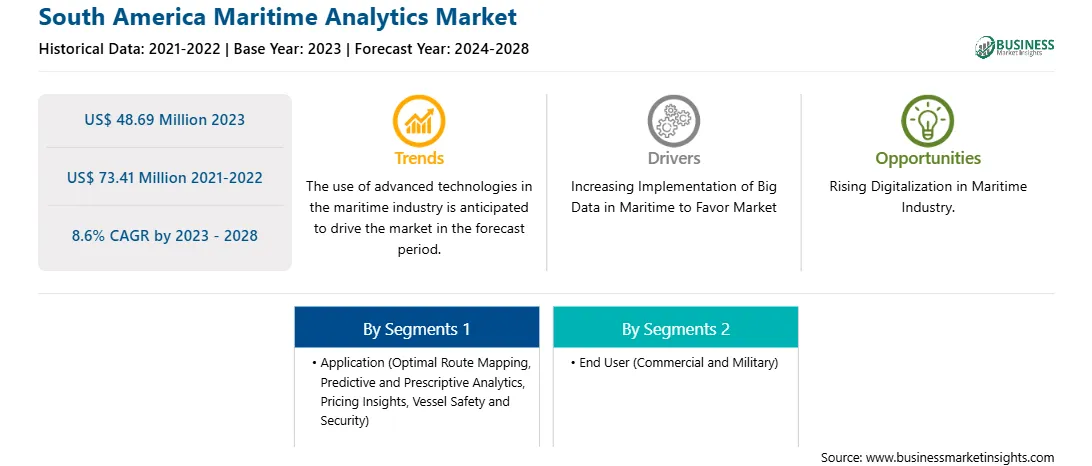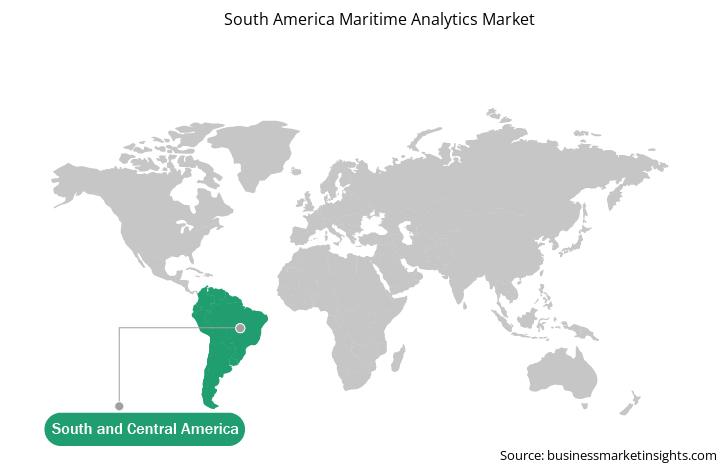The integration of digital technologies in maritime processes, operations, and business models to enhance productivity, increase security, and reduce operational costs has been growing at an unprecedented rate. Due to escalating customer demands and industry competitiveness, digital transformation has become a fundamental need for any company's long-term success and competitive advantage. Companies worldwide are adopting digitization to improve their business processes to increase operational throughput and profits. The marine industry is no exception to this tendency, and it is currently undergoing a paradigm transition because of shifting business models, technological adoption, cost structures, and increased competition. The key areas for digital transformation in the maritime industry include developing new business models, digitalizing core operations, and using analytics for better decision-making. Companies use maritime analytics to improve their daily operations, including cargo handling, port operations, vessel deployment, empty repositioning, and freight routing. Factors such as process optimization, high operational efficiency, cost reduction, and the prevention of human errors are fueling the demand for digital solutions in the global maritime industry.
Since growing digitalization is making maritime a data-rich industry globally, the penetration of descriptive analytics, predictive analytics, diagnostic analytics, and prescriptive analytics is also gaining prominence in maritime operations. This factor is contributing to the overall growth of the maritime analytics market. The maritime industry has understood the value of utilizing analytics and data to bring transparency and drive more efficiency in maritime. More and more companies globally are investing in maritime analytics technologies to drive efficiency in \ trade, gain full visibility for their cargo, optimize ship operations, and boost port operations efficiency. The rising demand for smarter and more advanced solutions in shipping and maritime is backed by an increasing number of maritime technology companies. Use of advanced maritime technology coupled with rising number of players is driving the scope of maritime analytics market.
South America comprises fast-growing economies such as Brazil, Argentina, and Colombia, along with the strong presence of several small island nations. The strong presence of tourism and commercial marine industries has contributed significantly to the notable number of marine vessels and marinas for sea-related leisure and sports activities. The industry is heavily fragmented, with a significant number of small players facilitating development of port infrastructure and technological adoption for seamless operation across prominent commercial ports throughout Latin American countries. Colon and Balboa ports in Panama and Santos in Brazil are among the leading container ports of the region.
Countries such as Brazil, Argentina, and Colombia are increasingly witnessing a surge in international trade volume. As per UNCTAD, maritime trade in Latin America and the Caribbean (LAC) in 2021, including goods loaded and discharged, witnessed a 3% increase over 2020. Such trade growth has attracted notable modernization of their maritime asset management and operation through technologically advanced solutions. Though currently, the major share of the maritime-related infrastructure is consolidated in Brazil, which has emerged as a focus point for goods trade through South America. However, other countries such as Colombia, Argentina, and Peru are expected to attract moderate demand for data analytics solutions in the coming years.
Strategic insights for the South America Maritime Analytics provides data-driven analysis of the industry landscape, including current trends, key players, and regional nuances. These insights offer actionable recommendations, enabling readers to differentiate themselves from competitors by identifying untapped segments or developing unique value propositions. Leveraging data analytics, these insights help industry players anticipate the market shifts, whether investors, manufacturers, or other stakeholders. A future-oriented perspective is essential, helping stakeholders anticipate market shifts and position themselves for long-term success in this dynamic region. Ultimately, effective strategic insights empower readers to make informed decisions that drive profitability and achieve their business objectives within the market.

| Report Attribute | Details |
|---|---|
| Market size in 2023 | US$ 48.69 Million |
| Market Size by 2028 | US$ 73.41 Million |
| Global CAGR (2023 - 2028) | 8.6% |
| Historical Data | 2021-2022 |
| Forecast period | 2024-2028 |
| Segments Covered |
By Application
|
| Regions and Countries Covered | South and Central America
|
| Market leaders and key company profiles |
The geographic scope of the South America Maritime Analytics refers to the specific areas in which a business operates and competes. Understanding local distinctions, such as diverse consumer preferences (e.g., demand for specific plug types or battery backup durations), varying economic conditions, and regulatory environments, is crucial for tailoring strategies to specific markets. Businesses can expand their reach by identifying underserved areas or adapting their offerings to meet local demands. A clear market focus allows for more effective resource allocation, targeted marketing campaigns, and better positioning against local competitors, ultimately driving growth in those targeted areas.

The South America maritime analytics market is segmented into application, end user, and country.
Based on application, the maritime analytics market is divided into optimal route mapping, predictive & prescriptive analytics, pricing insights, vessel safety & security, and others. The predictive & prescriptive analytics segment held the largest market share in 2023.
Based on end user, the market is bifurcated into commercial and defense. The commercial segment held the largest market share in 2023.
Based on country, the South America maritime analytics market is segmented into Brazil, Argentina, and the Rest of South America. Brazil dominated the market in 2023.
ShipNet; Kpler; LgMAR; and Windward Ltd are the leading companies operating in the South America maritime analytics market.
The South America Maritime Analytics Market is valued at US$ 48.69 Million in 2023, it is projected to reach US$ 73.41 Million by 2028.
As per our report South America Maritime Analytics Market, the market size is valued at US$ 48.69 Million in 2023, projecting it to reach US$ 73.41 Million by 2028. This translates to a CAGR of approximately 8.6% during the forecast period.
The South America Maritime Analytics Market report typically cover these key segments-
The historic period, base year, and forecast period can vary slightly depending on the specific market research report. However, for the South America Maritime Analytics Market report:
The South America Maritime Analytics Market is populated by several key players, each contributing to its growth and innovation. Some of the major players include:
The South America Maritime Analytics Market report is valuable for diverse stakeholders, including:
Essentially, anyone involved in or considering involvement in the South America Maritime Analytics Market value chain can benefit from the information contained in a comprehensive market report.